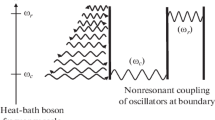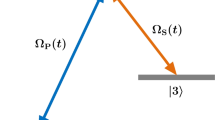We consider the escape of a photon from a single-mode optical cavity with a controlled variable intensity. The source of the photon is a relaxing two-level atom. The quantum bottleneck effect involves a counterintuitive decrease of the probability of photon escape from the cavity with the increase of its escape intensity. Numerical simulations of the process were carried out using the basic Lindblad quantum equation for the Jaynes-Cummings model with thermal relaxation. A quasi-classical description of the bottleneck mechanism is presented, similar to the Zeno effect. The counterintuitive behavior described plays an important role in the description of the exchange of single photons in nanosystems and in molecular complexes converting solar energy in bacteria.
Similar content being viewed by others
References
M. A. Martin-Delgado, On Quantum Effects in a Theory of Biological Evolution, Scientific Reports, Vol. 2, Article Number 302 (2012); doi: 10.1038/srep00302.
V. Ogryzko and Y. Ozhigov, “Biologically inspired path to quantum computer,” in: Proceedings of SPIE, Vol. 9440, 9440C1–9440C10 (2014).
R. E. Fenna and B. W. Matthews, “Chlorophyll arrangement in a bacteriochlorophyll protein from Chlorobium limicola,” Nature,258 (5536), 573–577; Bibcode: 1975 Natur.258.573F; doi: 10.1038/258573a0.
M. Plenio et al., “Dephasing assisted transport: Quantum networks and biomolecules,” New J. Phys.,10, 113019 (2008).
S. Huelga and M. Plenio, “Vibration, quanta and biology,” Contemp. Phys.,54, 181–207 (2013)
C. T. Rodgers and P. J. Hore, “Chemical magnetoreception in birds: the radical pair mechanism,” Proc. Nat. Acad. Sci. United States of America,106, No. 2, 353–60 (2009).
R. J. Gegear, A. Casselman, S. Waddell, and S. M. Reppert, “Cryptochrome mediates light-dependent magnetosensitivity in Drosophila,” Nature,454(7207), 1014–1018 (August 2008).
E. Wajnberg, D. Acosta-Avalos, O. C. Alves, J. F. de Oliveira, R. B. Srygley, and D. Esquivel, “Magnetoreception in eusocial insects: an update,” J. Royal Society Interface,7 (Suppl 2), S207–S225 (2010).
H. G. Hiscock, S. Worster, D. R. Kattnig, C. Steers, Y. Jin, D. E. Manolopoulos, H. Mouritsen, and P. J. Hore, “The quantum needle of the avian magnetic compass,” in: Proc. Natl. Acad. Sci. USA. Apr 26;113(17) (2016), p. 4634-9; doi: 10.1073/pnas.1600341113.Epub 2016 Apr 4.
Yu. I. Ozhigov and N. A. Skovoroda, “Conductivity of atomic excitations in a system of optical cavities,” Matem. Modelirovanie,29, No. 12, 123–134.
A. V. Kulagin, V. Y. Ladunov, Y. I. Ozhigov, N. A. Skovoroda, and N. B. Victorova , “Homogeneous atomic ensembles and single-mode field: review of simulation results,” in: Proc. of SPIE,11022, 110222C1–110222C12 (2019).
A. Tomadin and R. Fazio, “Many-body phenomena in QED-cavity arrays,” J. Opt. Soc. Am. B,27, A130 (2010).
Author information
Authors and Affiliations
Corresponding author
Additional information
Translated from Prikladnaya Matematika i Informatika, No. 62, 2019, pp. 5–12.
Rights and permissions
About this article
Cite this article
Victorova, N.B., Kulagin, A.V. & Ozhigov, Y.I. Quasi-Classical Description of the “Quantum Bottleneck” Effect for Thermal Relaxation of an Atom in a Resonator. Comput Math Model 31, 1–7 (2020). https://doi.org/10.1007/s10598-020-09470-2
Published:
Issue Date:
DOI: https://doi.org/10.1007/s10598-020-09470-2




